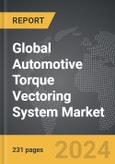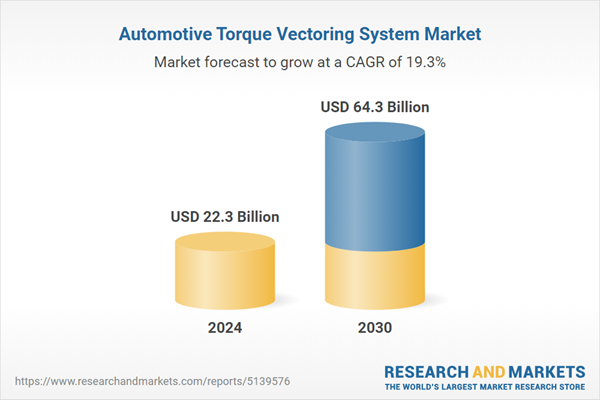The global market for Automotive Torque Vectoring System was valued at US$22.3 Billion in 2024 and is projected to reach US$64.3 Billion by 2030, growing at a CAGR of 19.3% from 2024 to 2030. This comprehensive report provides an in-depth analysis of market trends, drivers, and forecasts, helping you make informed business decisions. The report includes the most recent global tariff developments and how they impact the Automotive Torque Vectoring System market.
Segments: Technology (Passive Torque Vectoring System (PTVS), Active Torque Vectoring System (ATVS)); Clutch Actuation Type (Hydraulic, Electronic).
Geographic Regions/Countries: World; United States; Canada; Japan; China; Europe (France; Germany; Italy; United Kingdom; Spain; Russia; and Rest of Europe); Asia-Pacific (Australia; India; South Korea; and Rest of Asia-Pacific); Latin America (Argentina; Brazil; Mexico; and Rest of Latin America); Middle East (Iran; Israel; Saudi Arabia; United Arab Emirates; and Rest of Middle East); and Africa.
The analysts continuously track trade developments worldwide, drawing insights from leading global economists and over 200 industry and policy institutions, including think tanks, trade organizations, and national economic advisory bodies. This intelligence is integrated into forecasting models to provide timely, data-driven analysis of emerging risks and opportunities.
Global Automotive Torque Vectoring System Market - Key Trends and Drivers Summarized
How Is Torque Vectoring Revolutionizing Vehicle Dynamics and Handling?
Automotive torque vectoring systems represent a groundbreaking innovation in vehicle dynamics, significantly enhancing a vehicle’s handling and stability, particularly in high-performance and all-wheel-drive vehicles. This technology allows for the distribution of torque to individual wheels, enabling more precise control over the vehicle's movement. By selectively applying power to the wheels with the most grip, torque vectoring helps improve traction, reduce understeer or oversteer, and enhance cornering performance. The system operates seamlessly with other vehicle dynamics control systems, such as electronic stability control (ESC) and anti-lock braking systems (ABS), to deliver a more responsive and controlled driving experience. This technology is especially valuable in challenging driving conditions, such as wet or icy roads, where maintaining traction is crucial. As a result, torque vectoring has become a key feature in modern vehicles, particularly in the premium and performance segments, where it contributes to superior handling and driver confidence.Why Is Torque Vectoring a Game-Changer for Electric and Hybrid Vehicles?
Torque vectoring is increasingly becoming a standard feature in electric and hybrid vehicles, where its benefits are even more pronounced. In these vehicles, which often have multiple electric motors powering different wheels or axles, torque vectoring can be used to independently control the torque delivered to each wheel. This level of control is particularly advantageous in electric vehicles (EVs), where the instant torque delivery from electric motors can lead to wheel spin or loss of traction if not properly managed. Torque vectoring helps mitigate these issues by ensuring that power is distributed optimally, enhancing both acceleration and cornering performance. In hybrid vehicles, which combine internal combustion engines with electric motors, torque vectoring can balance the power delivery between the different power sources, improving efficiency and performance. As the automotive industry continues to move towards electrification, the integration of torque vectoring systems is expected to become increasingly common, offering a critical advantage in the management of power and performance in these vehicles.How Are Advances in Torque Vectoring Technology Shaping the Future of Autonomous Driving?
The development of torque vectoring technology is also playing a crucial role in the advancement of autonomous driving systems. Autonomous vehicles require highly sophisticated control systems to ensure safety and comfort, and torque vectoring provides an additional layer of precision in vehicle dynamics. By enabling more accurate control over each wheel's torque, these systems can improve the vehicle's ability to navigate complex driving scenarios, such as sharp turns, sudden lane changes, or emergency maneuvers. Torque vectoring can also enhance the stability and comfort of autonomous vehicles by minimizing body roll and pitch during acceleration and braking. As the technology continues to evolve, it is likely to become an integral component of autonomous driving platforms, contributing to smoother, safer, and more predictable vehicle behavior. Moreover, as automakers push the boundaries of what autonomous vehicles can do, torque vectoring will be essential in achieving the high levels of control and precision required for fully autonomous operation.What Are the Key Factors Driving the Growth of the Automotive Torque Vectoring Market?
The growth in the automotive torque vectoring market is driven by several factors, all closely linked to the evolving landscape of vehicle technology and consumer demands. The increasing popularity of electric and hybrid vehicles, which benefit significantly from the enhanced control and efficiency provided by torque vectoring, is a major growth driver. Additionally, the rising consumer demand for high-performance vehicles that offer superior handling and stability is pushing automakers to incorporate advanced torque vectoring systems into their models. The ongoing development of autonomous driving technologies is also fueling the demand for torque vectoring, as it plays a crucial role in ensuring the precision and safety of self-driving cars. Furthermore, the trend towards vehicle electrification and the need for more efficient power management systems are leading to greater adoption of torque vectoring in a wider range of vehicles. Finally, stringent safety regulations and the push for improved vehicle dynamics and control are encouraging automakers to invest in torque vectoring technology, driving further expansion in this market.Report Scope
The report analyzes the Automotive Torque Vectoring System market, presented in terms of units. The analysis covers the key segments and geographic regions outlined below.Segments: Technology (Passive Torque Vectoring System (PTVS), Active Torque Vectoring System (ATVS)); Clutch Actuation Type (Hydraulic, Electronic).
Geographic Regions/Countries: World; United States; Canada; Japan; China; Europe (France; Germany; Italy; United Kingdom; Spain; Russia; and Rest of Europe); Asia-Pacific (Australia; India; South Korea; and Rest of Asia-Pacific); Latin America (Argentina; Brazil; Mexico; and Rest of Latin America); Middle East (Iran; Israel; Saudi Arabia; United Arab Emirates; and Rest of Middle East); and Africa.
Key Insights:
- Market Growth: Understand the significant growth trajectory of the Passive Torque Vectoring System (PTVS) segment, which is expected to reach US$39.6 Billion by 2030 with a CAGR of a 18.1%. The Active Torque Vectoring System (ATVS) segment is also set to grow at 21.4% CAGR over the analysis period.
- Regional Analysis: Gain insights into the U.S. market, valued at $5.6 Billion in 2024, and China, forecasted to grow at an impressive 24.1% CAGR to reach $17.0 Billion by 2030. Discover growth trends in other key regions, including Japan, Canada, Germany, and the Asia-Pacific.
Why You Should Buy This Report:
- Detailed Market Analysis: Access a thorough analysis of the Global Automotive Torque Vectoring System Market, covering all major geographic regions and market segments.
- Competitive Insights: Get an overview of the competitive landscape, including the market presence of major players across different geographies.
- Future Trends and Drivers: Understand the key trends and drivers shaping the future of the Global Automotive Torque Vectoring System Market.
- Actionable Insights: Benefit from actionable insights that can help you identify new revenue opportunities and make strategic business decisions.
Key Questions Answered:
- How is the Global Automotive Torque Vectoring System Market expected to evolve by 2030?
- What are the main drivers and restraints affecting the market?
- Which market segments will grow the most over the forecast period?
- How will market shares for different regions and segments change by 2030?
- Who are the leading players in the market, and what are their prospects?
Report Features:
- Comprehensive Market Data: Independent analysis of annual sales and market forecasts in US$ Million from 2024 to 2030.
- In-Depth Regional Analysis: Detailed insights into key markets, including the U.S., China, Japan, Canada, Europe, Asia-Pacific, Latin America, Middle East, and Africa.
- Company Profiles: Coverage of players such as BorgWarner, Inc., Bosch Rexroth Corporation, Continental AG, Dana, Inc., EXEDY Corporation and more.
- Complimentary Updates: Receive free report updates for one year to keep you informed of the latest market developments.
Some of the 16 companies featured in this Automotive Torque Vectoring System market report include:
- BorgWarner, Inc.
- Bosch Rexroth Corporation
- Continental AG
- Dana, Inc.
- EXEDY Corporation
- GKN PLC
- Magna International, Inc.
- ZF Friedrichshafen AG
Tariff Impact Analysis: Key Insights for 2025
Global tariff negotiations across 180+ countries are reshaping supply chains, costs, and competitiveness. This report reflects the latest developments as of April 2025 and incorporates forward-looking insights into the market outlook.The analysts continuously track trade developments worldwide, drawing insights from leading global economists and over 200 industry and policy institutions, including think tanks, trade organizations, and national economic advisory bodies. This intelligence is integrated into forecasting models to provide timely, data-driven analysis of emerging risks and opportunities.
What’s Included in This Edition:
- Tariff-adjusted market forecasts by region and segment
- Analysis of cost and supply chain implications by sourcing and trade exposure
- Strategic insights into geographic shifts
Buyers receive a free July 2025 update with:
- Finalized tariff impacts and new trade agreement effects
- Updated projections reflecting global sourcing and cost shifts
- Expanded country-specific coverage across the industry
Table of Contents
I. METHODOLOGYII. EXECUTIVE SUMMARY2. FOCUS ON SELECT PLAYERSIII. MARKET ANALYSISSOUTH KOREAREST OF ASIA-PACIFICARGENTINABRAZILMEXICOREST OF LATIN AMERICAIRANISRAELSAUDI ARABIAUNITED ARAB EMIRATESREST OF MIDDLE EASTIV. COMPETITION
1. MARKET OVERVIEW
3. MARKET TRENDS & DRIVERS
4. GLOBAL MARKET PERSPECTIVE
UNITED STATES
CANADA
JAPAN
CHINA
EUROPE
FRANCE
GERMANY
ITALY
UNITED KINGDOM
SPAIN
RUSSIA
REST OF EUROPE
ASIA-PACIFIC
AUSTRALIA
INDIA
LATIN AMERICA
MIDDLE EAST
AFRICA
Companies Mentioned (Partial List)
A selection of companies mentioned in this report includes, but is not limited to:
- BorgWarner, Inc.
- Bosch Rexroth Corporation
- Continental AG
- Dana, Inc.
- EXEDY Corporation
- GKN PLC
- Magna International, Inc.
- ZF Friedrichshafen AG
Table Information
| Report Attribute | Details |
|---|---|
| No. of Pages | 231 |
| Published | April 2025 |
| Forecast Period | 2024 - 2030 |
| Estimated Market Value ( USD | $ 22.3 Billion |
| Forecasted Market Value ( USD | $ 64.3 Billion |
| Compound Annual Growth Rate | 19.3% |
| Regions Covered | Global |









